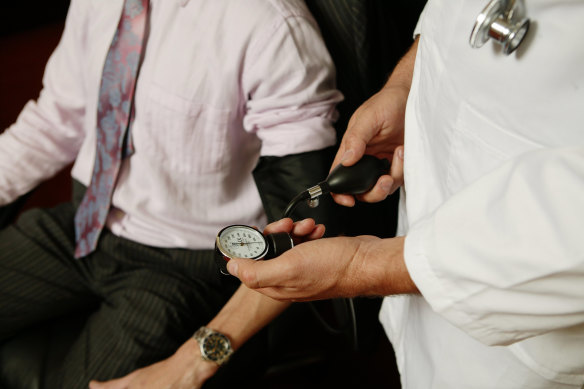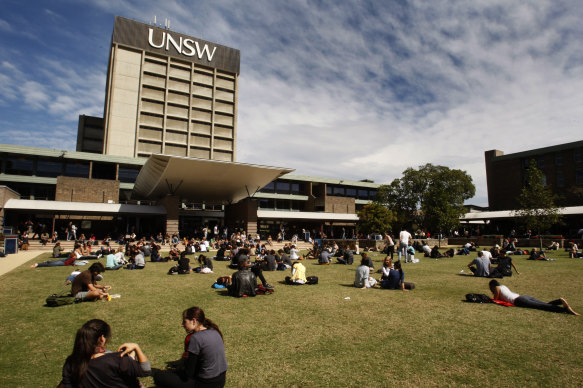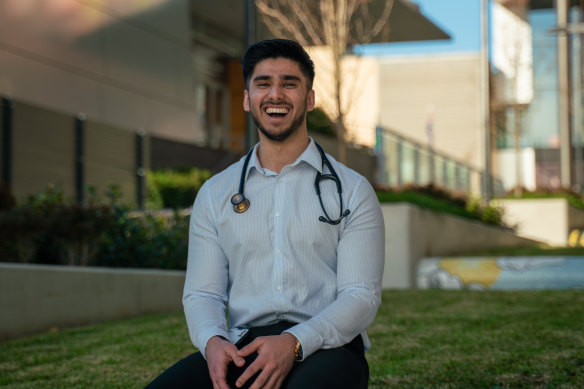Save articles for later
Add articles to your saved list and come back to them any time.
Thousands of high school students aspire to get into medical school every year. To have a hope of gaining entry, they have to have a near-perfect ATAR and sit a separate aptitude test and score nearly perfect marks in that, too.
If they clear those two hurdles, they will be asked to do something they might not be expecting: sign a non-disclosure agreement before they are interviewed by a member of the public.
Future doctors are interviewed by members of the public to gain admission to medical school.Credit: Andrew Quilty
“They’re the ones who go to the doctor,” the dean of Western Sydney University’s school of medicine, Professor Annemarie Hennessy, said.
“It is called a principle of co-design. We actually embrace the community and say, ‘How do you want to contribute to medical entry?’ ”
When it comes to the all-important interview, a lucrative industry has sprung up to target high school students hopeful of becoming a doctor, promising to coach them on how to beat their competition to secure a spot.
“My best advice is there is no evidence the extortionist prices charged by those agencies or the information provided has any impact on entry,” Hennessey said.
About 4000 students from across the country put down Western Sydney University as their first, second or third preference every year, Hennessy said.
The minimum Australian Tertiary Admissions Rank (ATAR) is 95.5 and 93.5 for those living in western Sydney. Students must also sit the University Clinical Aptitude Test and if they also get a satisfactory result, 400 of them proceed to the interview stage. Of those, only 100 will be offered a spot.
The reason students must sign a non-disclosure agreement before the interview is to protect the integrity of the questions – which she says focus on learning more about who the applicant is as a person.
“They’re often about the sorts of traits you would want– someone who is compassionate, a good listener … who has resilience and can work in teams,” she said.
The University of NSW’s medical course has been the most in demand for the past 20 years.Credit: Louise Kennerley
“I say to students, ATAR is a surrogate for effort. We’re really interested in your dedication to hard work.”
For the past 20 years, studying medicine at the University of NSW has been the most popular course. Each year, most applications are rejected.
The university was the top choice again this year with 1645 students putting it down as their first preference. The University of Newcastle and the University of New England’s joint program is the next most popular course followed by Western Sydney University and Charles Sturt University’s joint doctor of medicine.
University of NSW student Laurence Lancaster, 19, was one of about 290 students who started their first year of medical school this year. On top of studying for the HSC, he did some practice for the University Clinical Aptitude Test, which he said was difficult via online websites. But he stopped short of paying for advice about the interview.
University of NSW student Laurence Lancaster, 19, was one of about 290 students who started their first year of medical school this year.Credit: Brook Mitchell
“I had doubts that I [would] get in. Not everyone is going to get in … I was thinking broadly about what back-ups I had,” he said.
In the HSC he studied extension 2 mathematics, extension 1 English, Chinese, chemistry and physics. He received an ATAR of 99.65, received a high score for the aptitude test which is sat in July or August and proceeded to the interview round– for which he said he did not get coaching.
“It is about your character. It is more of a getting to know you and what drives you. I just spoke about my passions and motivations which drive me. I think they’re more focused on how they see you working in a medical environment,” he said.
Interim dean of the UNSW Faculty of Medicine & Health Adrienne Torda said the reason they conducted interviews was that they wanted someone with the right personality for the job.
“We know there are many elements to being a good doctor, a successful doctor, which are beyond academic performance,” Torda said.
It is also about making sure students are committed. “It is six years of university learning, two to four years as a junior medical officer in a hospital and then more years of specialising in general practice or a hospital-based speciality … it is 12 to 16 years before someone becomes a specialist,” she said.
She said the nondisclosure agreement was put in place to avoid misleading future applicants.
“In our interviews, we expect applicants to be honest and provide genuine answers. If information from the interviews goes out, it may impact answers of future applicants and may compromise their performance in the interview. Hence, the less information goes out the better the outcomes for the applicants,” she said.
Surgeons and anaesthetists have an average total income of more than $400,000, according to tax office data, but Torda said students were not motivated by money.
Western Sydney University medical school student Fahad Khan.
“I don’t think they would come into it for the money. Maybe that was the case in the past but not now compared to other careers where they would be earning much more much faster,” Torda said.
Someone with a keen insight into the motivations of thousands of aspiring medical student is Fahad Khan. He failed to get into a medicine program straight out of school, did an undergraduate degree in neuroscience at the University of NSW before enrolling in a doctorate of medicine at Western Sydney University.
He has a TikTok account where he discusses life in medical school and also operates a tutoring business. A lot of those who dreamt of a career in medicine wanted to help people, but there were exceptions to the rule.
“There are a concerning number of students who are there for other reasons like status … they want to be a leader in a high-stakes area,” he said.
Additionally, many students chose the subject because they did not want to “waste” a high ATAR on a course that does not require it, Khan said.
There are about 290 spots in the UNSW course, 100 in the Western Sydney University and Charles Sturt program and 170 places at University of Newcastle and the University of New England joint program.
The University of Sydney is possibly the hardest to get into: students apply directly to the university and, of the 220 spots in the course, only 30 are for undergraduates. The entry score is ATAR 99.95.
The dean, Professor Cheryl Jones, said about 15 years ago the university had overhauled its offering, so most spots were now offered to postgraduate students.
“It is intentionally that way so the majority come through from whatever undergraduate degree …
part of the reason is to have a more diverse student cohort, not simply students who got very, very high ATARs,” she said.
The 30 spots for undergraduates mean they complete either a science or arts degree first and, so long as they maintain a credit average, they are given direct access to the doctor of medicine program.
“The cohort coming through that pathway are often very engaged in undertaking research. They are one part of the type of doctor; not everyone has to have an ATAR of 99.95 … we like people from all backgrounds,” she said.
More from Campus
2024 most popular degrees: Watch out medicine, students are applying for business degrees in greater numbers than ever before. What will our future workforce look like? Read about NSW’s most popular degrees here.
Give it a break: Comedian Lizzy Hoo says a commerce degree can wait. In her gap year she mastered snowboarding, living off obscenely small amounts of cash and bailing friends out of jail. Valuable life skills, she argues.
Face time: Being allowed to attend lectures and tutorials online may be convenient, but is it time to bring back punitive measures so students attend university IRL?
A matter of degrees: Not sure what to study and need some course inspiration? Think being a lawyer for outer space territories sounds good? Check out these degrees you probably have never heard of.
Result driven: From a hands-on paid gap year in the Defence Force to scaling the tech world, get a pay packet sooner with these fast-track career qualifications – no university required.
The Morning Edition newsletter is our guide to the day’s most important and interesting stories, analysis and insights. Sign up here.
Most Viewed in National
From our partners
Source: Read Full Article



